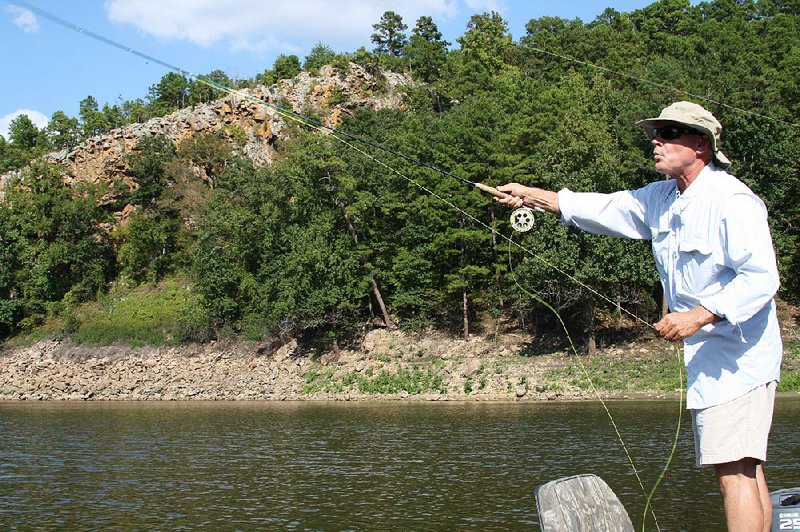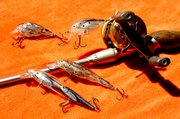LAKE NIMROD -- Fly fishing for schooling crappie was a new one on me, but that was just part of the excitement Tuesday at Lake Nimrod.
Created in 1942 by impounding the Fourche LaFave River, Lake Nimrod is the oldest Corps of Engineers reservoir in Arkansas. It's also one of the hottest bass lakes in Arkansas because of a series of strong year classes that resulted from prolonged periods of high water.
Rusty Pruitt of Bryant had been trying to talk me into a trout fishing trip to north Arkansas, but a simple text message was all it took to reroute his priorities.
"I know some nimrods, but none that fish," Pruitt replied.
For the record, Nimrod was a grandson of the biblical patriarch Noah, builder of the Ark. He is described in Genesis 10:9 as "a mighty hunter before the Lord," and as a hunter was second only to Esau in fame.
"I wonder how that got to be pejorative?" Pruitt asked as we drove north on the breathtakingly scenic Arkansas 7.
"An elitist stereotype, or maybe just the way it sounds," I speculated. "It sounds like an insult, ya NIM-rod!"
Many years have passed since I last fished the picturesque lake, but that last trip was one for the ages.
I owned a little Bass Tender two-person boat powered by a 3-horsepower Tanaka outboard in those days. The whole rig fit snugly in the back of my little Nissan pickup. High water inundated a small grove of trees near the campground. The Corps was draining a lot of water quickly, so a strong current stacked bass at one of the corners.
I caught them for two days on a silver glitter Poe's deep-diving crankbait. The smallest bass I caught was about 3 pounds, and the biggest was nearly 6 pounds. My rod broke while fighting that big one, so I hied to Russellville to get another. By the end of that last day the water fell to a point where the bass abandoned that little point, but it was an unforgettable run while it lasted.
I forgot a lot since then, so Tuesday was a lot like seeing Nimrod for the first time. Pruitt brought a set of coordinates for brush piles that date to the 1980s. Almost all of the boats on the lake seemed to be parked over deep brush piles, so we decided to fish by instinct.
A stiff wind blew from the south. Pruitt said there was a good chance the wind would concentrate shad on south-facing banks, so that's where we'd probably find bass and maybe white bass, too.
When I'm on unfamiliar water, the first thing I do is look for something familiar. Pruitt and I are creek fishermen at heart, so we entered the first creek we found. That's Brush Creek, the lake's largest tributary besides the Fourche LaFave River.
I like to use crankbaits to explore new water, and I chose an interesting selection from Live Target called the Bait Ball. It's a wide, square-bill crankbait with a clear plastic body. Inside are three tiny plastic shad on both sides and in the middle. It gives the lure a three-dimensional effect and resembles a small school of baitfish. It looks good in the hand, but it looks even better in the water.
As we rounded the first big bend out of the main lake, I cast to the shore and immediately got a strike. I got another strike a few casts later and caught a fat, 14-inch largemouth bass. I was smitten. I threw other baits for a change of pace now and then, but I stayed with the Bait Ball for nearly seven hours.
Pruitt used a spinning rig with our creekside favorite, a Zoom Tiny Lizard in pumpkinseed/red flake. Bass liked that even more than the crankbait, and he caught them in spurts all day.
Brush Creek is gorgeous, with a high, sloping outcrop that looms over the east side of the creek like a fortress wall. It's the most picturesque spot on the lake.
We followed the channel into the woods until we ran out of water. Despite exceedingly dry conditions, the water was highly stained and visibility was limited. The creek bottom contains a lot of chunk rock and a number of boulders, as well as a fair number of fallen trees. I caught one largemouth off one laydown with a brown jig, and I lost that jig on a substantial fish when I broke the line on the hookset.
I resumed fishing with the Bait Ball. I threw to the edge of a big rock on the bank and retrieved the lure without a bite. With the lure at the side of the boat, I swirled it in a Figure 8. A big fish blew up on it at the side of the boat with less than 18 inches of line out, but it was a glancing blow and we didn't connect.
When the water became too shallow, we turned around and worked slowly back toward the lake. It was about 2 p.m., and fish thrashed the surface from bank to bank.
Pruitt was bored with the spinning rig, so he switched to a 3-weight fly rod and a small bead-head nymph under a strike indicator. We thought the schooling fish were bass, but to our astonishment they were white crappie. They appeared to be eating some sort of emerging insect, and Pruitt's beadhead was the right lure for that occasion. He laughed maniacally as he caught one after another.
At the spot where the creek widens is a submerged brushtop. It was alive with fish, including a massive bull bluegill that hit the nymph.
We couldn't stand to leave, so we turned around and made another pass to the back of the creek, and we continued to catch fish.
As the sun sank over the ridges, we tore ourselves away and fished our way back out to the lake. The Bait Ball was definitely more effective there, and bass reacted to it violently. One 12-inch largemouth leaped out of the water and jumped on top of the lure while it sat on the surface.
There was no talk of trout and Ozark streams on the way home. Pruitt and I were happy and content at the good fishing we'd found much closer to home.
Sports on 09/20/2015

